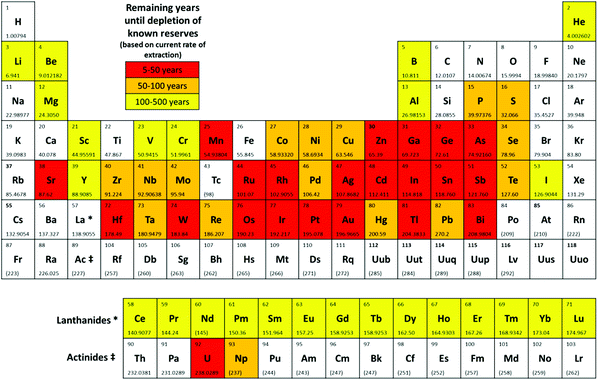The importance of elemental sustainability and critical element recovery
Andrew J.
Hunt
*a,
Avtar S.
Matharu
a,
Alexander H.
King
b and
James H.
Clark
a
aGreen Chemistry Centre of Excellence, Department of Chemistry, University of York, YO10 5DD, UK. E-mail: andrew.hunt@york.ac.uk
bCritical Materials Institute, The Ames Laboratory, U.S. Department of Energy, Ames, Iowa 50011-3020, USA
At first glance, Fig. 1 highlights a worrying trend in terms of the depletion of known reserves; however it is important to emphasise that the rates at which these elements are recycled and new deposits are being discovered are not accounted for in this figure. Elements are not lost but are simply spread throughout our environment in low concentration waste streams.2,3 This is especially true for end-of-life consumer and industrial products. Elemental extraction through mining is an energy intensive process and significant environmental burdens can also be attributed to these activities. The recycling of many elements is still limited and the adoption of multidisciplinary approaches to increase recycling rates is essential.1 It is envisaged that in the future a greater proportion of elements will be sourced from wastes including landfill sites, waste electrical and electronic equipment, contaminated waters, industrial wastes and mine tailings, but this will need a dramatic change in our waste management policies.4
 | ||
| Fig. 1 Remaining years until depletion of known reserves of elements. Reproduced from Ref. 1. | ||
The increased demand for these finite elemental resources and associated accessibility issues has led to concerns over the future security of supply. Many elements used by industry are now considered as “critical” for businesses or national economies. These “critical” elements will vary depending on the purpose of the assessment and needs of the organisation. Thus, criticality is truly “in the eyes of the beholder”. However, critical elements are typically those with significant supply restriction issues (geopolitical issues, conflicts, international monopolies and mining as a by-product of other elements) and those which would have a dramatic impact on a business or economy if limited.5
In this special issue of Green Chemistry, over 25 contributions have been collected from international leaders in extraction, manufacture, utilisation and recovery of elements to provide a snapshot of the current state of the art. This timely themed issue specifically addresses important aspects of elemental sustainability and critical element recovery. Holistic strategies for elemental use and recovery will be highlighted, alongside the development of new green technologies (catalysts or chemistries) and the importance of strategic partnerships to meet the significant future challenges that the chemical industry faces will be emphasised.
References
- A. J. Hunt, T. J. Farmer and J. H. Clark, in Element Recovery and Sustainability, ed. A. J. Hunt, Royal Society of Chemistry, London, 2013, ch. 1, pp. 1–28 Search PubMed.
- M. Z. Jacobson and M. A. Delucchi, Sci. Am., 2009, 11, 58 CrossRef PubMed.
- T. E. Graedel, J. Allwood, J.-P. Birat, M. Buchert, C. Hagelüken, B. K. Reck, S. F. Sibley and G. Sonnemann, J. Ind. Ecol., 2011, 15, 355–366 CrossRef CAS PubMed.
- J. R. Dodson, A. J. Hunt, H. L. Parker, Y. Yang and J. H. Clark, Chem. Eng. Process., 2012, 51, 69–78 CrossRef CAS PubMed.
- U.S Department of Energy, Critical Element Strategy, 2010 Search PubMed.
| This journal is © The Royal Society of Chemistry 2015 |
